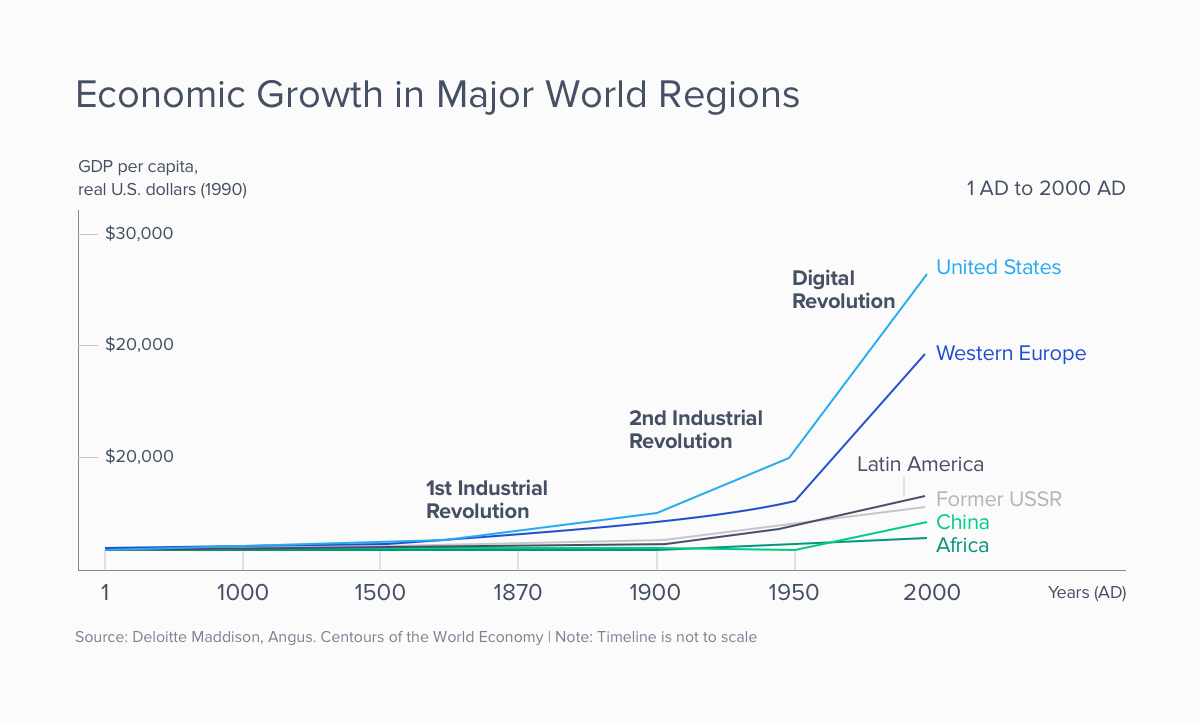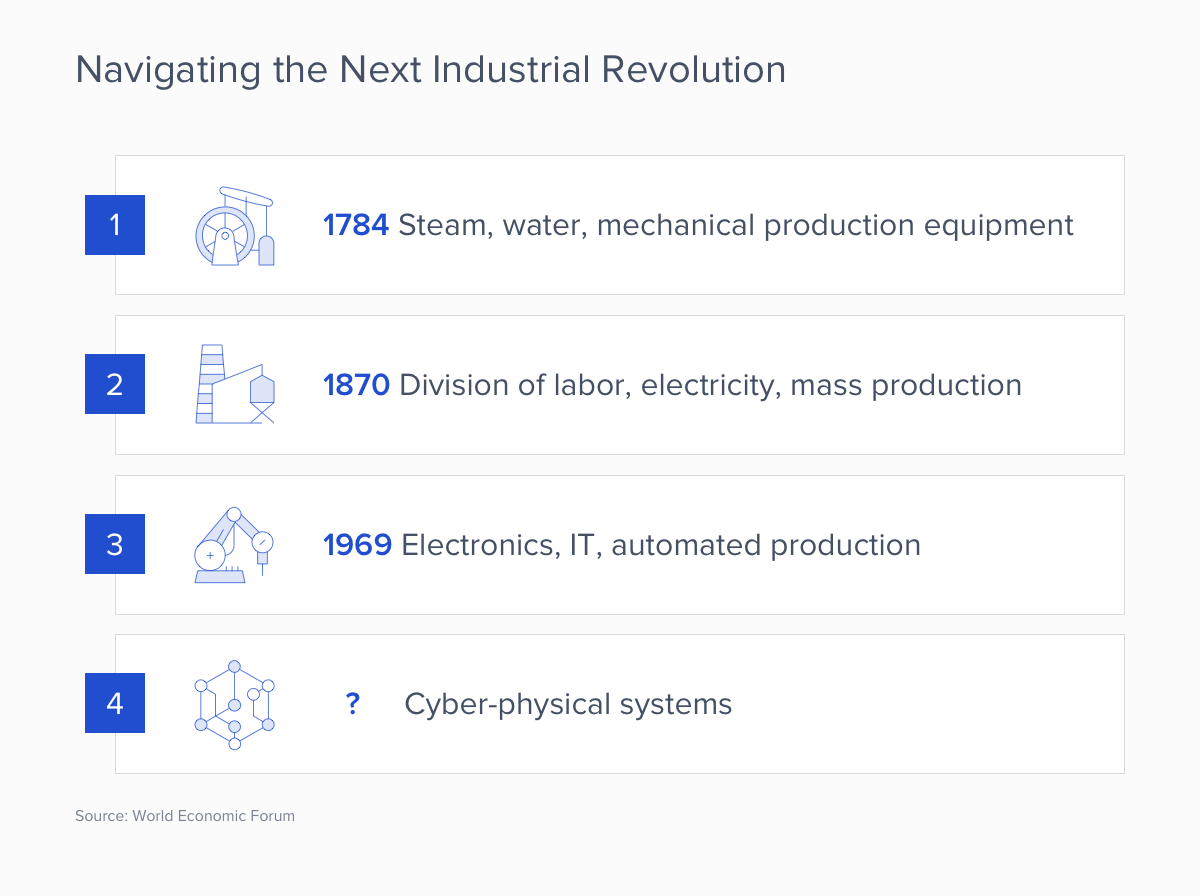The Big Picture: Macroeconomic Trends and the Impact on Staffing
authors are vetted experts in their fields and write on topics in which they are extremely knowledgeable. All of our content is peer reviewed and validated by world-class professionals.

- As the Fourth Industrial Revolution unfolds, digital technologies are doing for enterprise workforces what the steam engine and related technologies did for manufacturing more than 100 years ago.
- The impact on businesses will be significant, and the biggest change will be in how companies source and engage their workforces.
- In the future, talent, more than capital, will represent the critical factor of production, according to Professor Klaus Schwab.
- Visit Staffing.com's homepage for more.
How can we define an industrial revolution? It is a change in technology of such magnitude that its effects are felt throughout all facets of society, permanently reshaping it. In economics, it can be defined as a shift outwards of the Production Possibilities Frontier, which simply means that more goods can be produced with the same amount of resources.
I sell here, sir, what all the world desires to have. Power.
— Matthew Boulton to James Boswell, when Boswell visited the Boulton-Watt works in 1776
Everyone has studied the (First) Industrial Revolution in school, when the discovery of the applicability of steam to machines and the invention of the steam engine led to what was probably the biggest change in means of production and society ever.
In fact, most of the positive changes for mankind have taken place since then: increased life expectancy, urbanization, the abandonment of rural work in favor of industrial (and services) work, the availability of leisure time and activities outside of the leisure classes, and more. All of these factors can be summarized, succinctly, as sharp increases in standards of living. “The lower middle class in Western and Asian industrialized societies today has a higher living standard than the pope and the emperors of a few centuries back, in every dimension,” states economic historian Joel Mokyr. From a societal point of view, the First Industrial Revolution marked the end of feudalism.
With this in mind, it becomes even more exciting to think that many prominent academics and thinkers are heralding the arrival of the Fourth Industrial Revolution, a time that could bring a change potentially of the same magnitude to humankind.
But firstly, what were the other two industrial revolutions, and what makes this upcoming fourth one so extraordinary? In what way have they affected (and will affect) the way humans live and work?
The Second Industrial Revolution was heralded by the mass production and widespread use of electricity. At the end of the First Industrial Revolution, the new inventions did not bring innovation of such magnitude to sustain the pace of economic growth that had preceded them, leading to an economic depression in the second half of the 19th century. The development of new steel-working techniques and the pervasive use of electricity in plants, however, allowed the development of modern line manufacturing and, thus, a new production boom at the turn of the century. This is the time in which the automobile industry was born and thrived, and when cities grew large, modern, and full of skyscrapers.
The Third Industrial Revolution, again, followed after a period of economic depression and sociopolitical unrest, with, unfortunately, disastrous consequences: the Great Depression and the Weimar Republic in the US and Germany respectively, followed then by WWII. In this case, the large technological innovation was the introduction of computing after WWII, followed by semi-conductors and then the internet. It is clear how impactful this has been. Many modern mainstays in the economy have been made possible by this increase in computational power, such as securities pricing (and derivatives), global, fast, and cheap communication, and space exploration. The list is endless.
The figure below helps to visually quantify exactly how impactful these technological breakthroughs and revolutions have been for humanity (in the western world, of course).

It’s interesting to note that scholars are not unanimous on whether a Third Industrial Revolution has actually happened already. Professor Jeremy Rifkin of the University of Pennsylvania’s Wharton School, for instance, published a best-selling book defining the Third Industrial Revolution as a data-driven change in the economy, not dissimilarly to how we define the fourth such revolution.
The Fourth Industrial Revolution
The concept of a Fourth Industrial Revolution was first introduced in 2015 by Klaus Schwab, the founder and executive chairman of the World Economic Forum. He advocated that the world was on the brink of a new, disruptive, enormous technological change that would have an impact on mankind even greater than that of the First Industrial Revolution. Schwab defines the Fourth Industrial Revolution as being “characterized by a fusion of technologies that is blurring the lines between the physical, digital, and biological spheres.” These technologies are artificial intelligence (AI), robotics, Internet of Things (IoT), nanotechnology, biotechnology, and quantum computing. What makes this a new technical revolution, rather than the continuation of the digital and computing revolution started after WWII, is the “velocity, scope, and systems impact,” as well as the blurring of the lines between humans and machines. Not only is the speed of change exponential, but it is visible in every sphere of life.
Professors Erik Brynjolfsson and Andrew McAfee, authors of the Second Machine Age, state the impact of these new technologies vividly and succinctly: “Digital technologies are doing for human brainpower what the steam engine and related technologies did for human muscle power during the Industrial Revolution. They’re allowing us to overcome many limitations rapidly and to open up new frontiers with unprecedented speed. It’s a very big deal.”

Impact of New Technologies on Businesses
The Fourth Industrial Revolution is already having a profound and transformative impact on businesses:
- New technologies allow companies to drastically improve products and services. For instance, in the field of medicine, 3D printing technologies have been utilized to create customized prosthetics, amongst other extremely innovative uses.
- Increased collaboration leading to innovation. The increased level of connectedness and the necessity to collaborate to fully exploit the value of data leads to great technological advancements. Blockchain technologies are a prime example.
- A change in customer expectations and corporate accountability. Customers are now mostly digitally connected. They also have much greater power in influencing how businesses serve them and on the quality of the services and products they purchase. Customer experience is becoming increasingly important and can be continuously improved through analytics and product development. At the same time, businesses need to strike a balance between convenience and trust.
- Last, but not least, the Fourth Industrial Revolution is having a tremendous impact on organizational forms. This encompasses everything from business models, the way services are delivered, the skills required from managers, organizational culture, and corporate governance. But most importantly, this revolution is changing the organization of labor.
The Fourth Industrial Revolution and the Future of Work
Scholars and experts are unanimous in believing that by far the largest impact of the Fourth Industrial Revolution will be on labor organization, and thus on workers. As Professor Klaus Schwab posited in his seminal essay, “We cannot foresee at this point which scenario is likely to emerge... However, I am convinced of one thing—that in the future, talent, more than capital, will represent the critical factor of production. This will give rise to a job market increasingly segregated into ‘low-skill/low-pay’ and ‘high-skill/high-pay’ segments, which in turn will lead to an increase in social tensions.”
In another report on the Future of Jobs, The World Economic Forum identifies the following four key factors as having the largest impact in this increased dichotomy between high-skill/high-pay and low-skill/low-pay employment:
- Technological advances. “Ubiquitous high-speed mobile internet, artificial intelligence, widespread adoption of big data analytics, and cloud technology” are getting adopted at a faster and faster rate. This heightened technological pace means that a widening skill gap makes it increasingly more difficult for enterprises to fill vacant positions, particularly ones that cannot be automated.
- Changing geography of production, distribution, and value chains. A substantial number of firms reported intentions to relocate their activities in the next four years, with 74% citing the availability of skilled local workers as a key factor.
- Changes in employment type. Half of the employers that participated expected their workforce to reduce in absolute numbers, but at the same time they expected to utilize more flexible contractual agreements and contractors for specialized tasks.
- Increased automation. The increased automation of tasks such as communicating, managing, and decision making is expected to redistribute efforts on existing tasks between humans and machines.
These factors will have a great impact on the way that people work and live. Not only will some jobs be entirely displaced by automation, but the nature of the jobs that remain will substantially change, both in the way they are carried out (with a different split of tasks between humans and machines), but, fundamentally, in where those jobs will be.
The Modern Geography of Work
Much like the other industrial revolutions had a permanent impact on the way people live and work, the Fourth Industrial Revolution will shape global geographies. Since the end of the 18th century, people have gradually been abandoning rural areas and agricultural labor to move to cities and work in emerging industries and ancillary services. The impact of new technologies, however, means not only do rural areas offer fewer employment opportunities but also that not all urban centers are positioned to reap the benefits. Cities and countries are increasingly competing against each other for talent, with the ability to attract and develop talent being the necessary condition for explosive growth.
The McKinsey Institute published a comprehensive report titled The Future of Work in America: People and Places, Today and Tomorrow, which supports and confirms the key highlights of the impact of the Fourth Industrial Revolution on people and cities. “The trends outlined in this report could widen existing disparities between high-growth cities and struggling rural areas, and between high-wage workers and everyone else. But this is not a foregone conclusion.”
Technology Caused the Problem but Can Provide the Solution
In fact, connectedness, ease of communication, data-sharing, and collaborative innovations are key tenets of this fourth, digital revolution. All of these technologies allow for the removal (or, at the very least, reduction) of physical barriers, enabling fruitful communication and collaboration between individuals and organizations in different geographies.
A new wave of innovations are emerging, which will enable new and modern ways of working:
- Digital skills-matching platforms. AI can be used to identify and recruit suitable candidates, outside of traditional recruitment channels.
- On-demand workers. Communications technologies, modern workplace organization, and agile management enable companies to carry out complex projects without permanently altering organizational structures.
- Remote workers. Remote workers can close the skills gap and overcome geographical limitations without displacement, both for individuals and companies.
- Distributed workforces. Distributed workforces can take advantage of the unique conditions of different hub cities and agglomeration economies, creating truly global companies.
This paves the way for modern ways of working that do not necessarily have to be less efficient than the traditional ones. On the contrary, on-demand, remote, and distributed working could at the same time help employers fulfill their skilled staffing needs while enabling people across the globe to participate in the benefits and wellbeing that the new technical revolution can bring.
